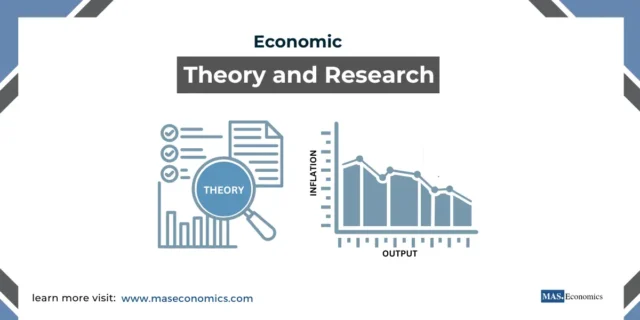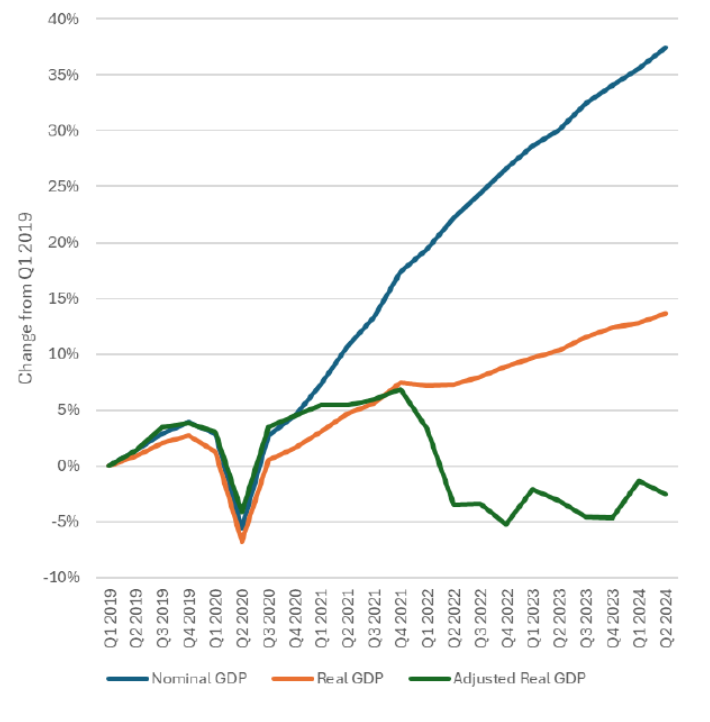In the field of economics, theory and research are deeply interconnected. While economic theory provides a conceptual framework for understanding how economies function, research is the empirical process that tests, refines, and supports these theoretical models. The relationship between economic theory and research is dynamic: theories guide the questions researchers ask and how they interpret their findings, while research offers the data needed to validate or challenge existing theories.
Economic theories, whether classical or modern, shape the way economists approach real-world problems. From predicting the effects of fiscal policy to explaining market behaviors, these theories are constantly tested and refined through rigorous empirical research. In this article, we will explore the critical role that theory plays in economic research, using real-world examples to illustrate how theories guide hypothesis generation, data analysis, and the development of new knowledge.
The Role of Theory in Economic Research
At its core, economic theory is a set of propositions and principles that explain or predict economic phenomena. Theories offer frameworks for understanding complex relationships, such as the interaction between supply and demand or the effects of monetary policy on inflation. However, for these theories to be useful, they must be tested and validated through research.
Theories in economics provide a roadmap for researchers. They help structure research questions, guide the formulation of hypotheses, and offer a framework for interpreting the data. For example, Keynesian economics predicts that government spending can stimulate demand during economic downturns. Researchers can use this theory to generate hypotheses about how fiscal policy might affect unemployment or economic growth, and then gather data to test these predictions.
Economic research, on the other hand, provides the empirical evidence needed to validate or challenge these theoretical models. As new data becomes available, researchers can refine existing theories or propose new ones that better reflect the evolving economic landscape.
How Economic Theories Guide Research
Theories in economics are not isolated from research; rather, they serve as the foundation for empirical investigation. Here’s how economic theory informs different stages of the research process:
Generating Research Questions
Economic theories help researchers identify the key questions they want to answer. For instance, a researcher interested in understanding the effects of monetary policy might turn to theories such as the Quantity Theory of Money or the Keynesian Liquidity Preference theory to frame their research question. These theories provide a basis for exploring how changes in money supply or interest rates influence inflation, investment, and overall economic activity.
Without a theoretical foundation, researchers would struggle to define clear, testable questions. Theories focus the research on specific economic mechanisms, making it easier to design studies that yield meaningful results.
Formulating Hypotheses
Once a research question is established, the next step is to formulate a hypothesis—a testable statement that predicts how variables are related. Economic theories play a crucial role in hypothesis generation. For example, the Phillips Curve theory suggests an inverse relationship between inflation and unemployment. Based on this theory, a researcher might hypothesize that “an increase in inflation will lead to a decrease in unemployment.”
In this way, economic theory transforms abstract ideas into concrete, testable propositions that guide the research process. Without theory, it would be difficult to generate hypotheses that are rooted in sound economic principles.
Data Collection and Analysis
Theories also guide how researchers collect and analyze data. For instance, if researchers are testing the predictions of Keynesian economics regarding fiscal stimulus, they would focus on collecting data related to government spending, GDP growth, and unemployment rates during periods of economic recession. The analysis would then aim to determine whether the data supports the Keynesian view that increased government spending stimulates economic activity.
Statistical and econometric tools are used to test the validity of theoretical predictions. Theories help determine which variables to analyze and which relationships to examine. For example, when testing the Phillips Curve, researchers would gather data on inflation and unemployment, then use regression analysis to assess whether the data supports the predicted inverse relationship.
Refining Economic Theories
Research not only tests existing theories but also refines them. As new data becomes available, economic theories can be updated to reflect changing conditions or to account for new information. For example, the Phillips Curve originally suggested a stable trade-off between inflation and unemployment. However, empirical research in the 1970s showed that this relationship broke down during periods of stagflation, leading to a revision of the theory and the introduction of concepts like the natural rate of unemployment.
In this way, research helps ensure that economic theories remain relevant and applicable in a constantly evolving global economy.
Examples of Theory and Research in Action
Several well-known economic theories illustrate the interplay between theory and research. Let’s explore a few examples.
Keynesian Economics and Fiscal Policy
Keynesian economics, introduced by John Maynard Keynes, posits that government intervention is necessary to stabilize the economy during periods of low demand. Specifically, Keynes argued that during a recession, governments should increase spending to boost aggregate demand, reduce unemployment, and stimulate economic growth.
Researchers have tested Keynesian predictions in various contexts. For instance, during the 2008 global financial crisis, many governments implemented large fiscal stimulus packages to prevent a deeper recession. Researchers analyzed the effects of these interventions by examining data on government spending, GDP growth, and employment levels. The findings generally supported Keynesian theory, showing that fiscal stimulus helped stabilize the economy in the short term.
This is a clear example of how theory shapes research. Keynesian economics provided the framework for understanding how fiscal policy could counteract a recession, and research confirmed that government spending played a crucial role in economic recovery.
The Phillips Curve and Inflation-Unemployment Trade-offs
The Phillips Curve, introduced by economist A.W. Phillips, describes an inverse relationship between inflation and unemployment: as inflation rises, unemployment falls, and vice versa. This theory gained significant attention in the 1960s and became a cornerstone of macroeconomic policy.
Researchers tested the Phillips Curve by analyzing historical data on inflation and unemployment. For much of the 20th century, the data appeared to support the theory. However, during the 1970s, the phenomenon of stagflation (high inflation and high unemployment) challenged the validity of the Phillips Curve. Economists responded by refining the theory to account for expectations of inflation, leading to the development of the expectations-augmented Phillips Curve.
This evolution illustrates how empirical research can modify or refine existing theories, ensuring that they remain relevant in the face of new economic realities.
Supply-Side Economics and Tax Policy
Supply-side economics, championed by economists like Arthur Laffer, argues that lowering taxes can stimulate economic growth by increasing investment and production. The Laffer Curve, a key concept in supply-side economics, suggests that there is an optimal tax rate that maximizes revenue. According to the theory, beyond a certain point, higher tax rates reduce incentives to work and invest, ultimately lowering government revenue.
Researchers have tested supply-side predictions by examining the effects of tax cuts on economic growth, investment, and government revenue. For example, after the Reagan tax cuts in the 1980s, researchers analyzed data to determine whether the tax cuts led to increased economic activity as predicted by supply-side theory. While the results were mixed, the research provided valuable insights into the conditions under which tax policy can stimulate growth.
This example shows how theory drives the formulation of research questions and how empirical research tests the assumptions behind economic theories.
The Continuous Feedback Loop Between Theory and Research
The relationship between economic theory and research is a continuous feedback loop. Theories provide the framework for research, guiding the formulation of hypotheses and shaping data analysis. At the same time, research generates new data that can either support, refine, or challenge existing theories.
This iterative process ensures that economic theories remain grounded in real-world evidence. When a theory fails to explain observed economic behavior, research helps identify its limitations and propose modifications. Conversely, when research confirms a theory, it strengthens its credibility and increases its applicability in policymaking and economic analysis.
Conclusion
Economic theory and research are inseparable components of the scientific process in economics. Theory provides the foundation for generating research questions, formulating hypotheses, and guiding data analysis. In turn, research offers the empirical evidence needed to test, refine, and improve these theories. Whether it’s validating Keynesian economics through fiscal policy analysis or refining the Phillips Curve in the face of new data, the interplay between theory and research drives progress in the field of economics.
As we move forward in this series, we will continue to explore how economic theories are tested, refined, and applied in various contexts, offering deeper insights into the complexities of economic research.
FAQs:
What is the role of economic theory in research?
Economic theory provides a conceptual framework for understanding economic phenomena and guides the research process. It helps researchers formulate questions, generate hypotheses, and interpret findings based on established principles and models.
How does economic theory guide research questions?
Economic theory helps identify key economic relationships and mechanisms, which in turn shape the research questions. For instance, theories like the Quantity Theory of Money or Keynesian economics can guide research into the effects of monetary policy on inflation or economic growth.
How do economic theories inform hypothesis formulation?
Theories in economics provide the foundation for formulating hypotheses. For example, the Phillips Curve theory suggests that inflation and unemployment are inversely related, leading to the hypothesis that “an increase in inflation will lead to a decrease in unemployment.”
How does research test economic theories?
Research tests economic theories by collecting empirical data and applying statistical methods to evaluate whether the data supports or refutes theoretical predictions. Through this process, researchers can validate or challenge the accuracy of a theory.
What is an example of economic theory guiding data collection?
When testing Keynesian economics, researchers collect data on government spending, GDP growth, and unemployment rates during recessions to analyze how fiscal stimulus affects economic activity. Theories help determine which variables and data are relevant for analysis.
Can economic theories be refined through research?
Yes, economic theories can be refined through research. As new data becomes available, researchers may modify existing theories to reflect real-world conditions better. For instance, the Phillips Curve was refined after empirical evidence of stagflation in the 1970s.
How do economic theories evolve over time?
Economic theories evolve as researchers test them with new data and refine them for changing economic conditions. For example, after empirical evidence challenged the original model, the Phillips Curve was adjusted to include inflation expectations.
What is the relationship between Keynesian economics and fiscal policy?
Keynesian economics suggests that government spending can stimulate demand and economic growth during downturns. This theory has been tested during periods of recession, such as the 2008 financial crisis, where fiscal stimulus was shown to have positive short-term effects.
How does the Phillips Curve illustrate the link between theory and research?
The Phillips Curve initially proposed an inverse relationship between inflation and unemployment, which was supported by empirical research. However, during the stagflation of the 1970s, research challenged the theory, leading to modifications like the expectations-augmented Phillips Curve.
What is the feedback loop between economic theory and research?
Economic theory and research form a continuous feedback loop. Theories guide research by providing a framework for testing, while research either validates, refines, or challenges these theories based on empirical evidence. This process ensures that theories remain relevant and accurate.
Thanks for reading! Share this with friends and spread the knowledge if you found it helpful.
Happy learning with MASEconomics




